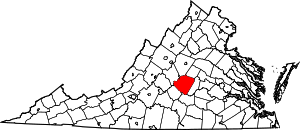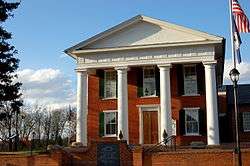Buckingham County, Virginia
| Buckingham County, Virginia | ||
|---|---|---|
|
Buckingham County Courthouse | ||
| ||
 Location in the state of Virginia | ||
 Virginia's location in the U.S. | ||
| Founded | 1761 | |
| Named for | Duke of Buckingham | |
| Seat | Buckingham | |
| Largest town | Dillwyn | |
| Area | ||
| • Total | 584 sq mi (1,513 km2) | |
| • Land | 580 sq mi (1,502 km2) | |
| • Water | 3.9 sq mi (10 km2), 0.7% | |
| Population | ||
| • (2010) | 17,146 | |
| • Density | 26/sq mi (10/km²) | |
| Congressional district | 5th | |
| Time zone | Eastern: UTC-5/-4 | |
| Website |
www | |
Buckingham County is a rural United States county located in the Commonwealth of Virginia, and containing the geographic center of the state. Buckingham County is part of the Piedmont region of Virginia, and the county seat is the town of Buckingham.[1]
Buckingham County was created in 1761 from the southeastern portion of Albemarle County and was predominantly farmland. The county was probably named in honor of the Duke of Buckingham, though the precise origin is uncertain. Several changes were made to the borders, until the existing boundaries were established in 1860.
As of the 2010 census, the county population was 17,146, and the county has experienced steady population growth over the preceding forty years.[2] Buckingham is also part of the Charlottesville Metropolitan Statistical Area.
History
Buckingham County, lying south of the James River at the geographic center of the state, was established on May 1, 1761 from the southeastern portion of Albemarle County. The origin of the county name probably comes from the Duke of Buckingham (Buckinghamshire, England). Some sources say that the county was named for Archibald Cary's estate "Buckingham" which was located on Willis Creek.[3] This is the only Buckingham County in the United States.
In 1778 a small triangular area bordering the James River was given to Cumberland County. In 1845, another part was taken from Buckingham to form the northern portion of Appomattox County. A final adjustment of the Appomattox-Buckingham county line was made in 1860 and Buckingham's borders then became fixed in their current form. A fire destroyed the courthouse (designed by Thomas Jefferson) in 1869 and most of the early records of this county were lost.
In the nineteenth century the county was devoted chiefly to large farms, which converted from tobacco cultivation to mixed farming and pulpwood harvesting. Large tracts of land belong to companies such as WestVaco that sell pulpwood and other timber products to the paper mills and wood product producers. It is still largely rural with areas devoted to great recreation such as fishing and hunting. The County is home to families that can trace their ancestry back to the very early beginnings of Virginia History. Many families still live on tracts of land that were given to their families as land grants. These land grants were originally given to French Huguenots who first settled the south western part of the county in the early 1700s.
Lee’s army marched through the county during Lee’s retreat on their way to Appomattox, Virginia. A marker in the cemetery of Trinity Presbyterian Church in New Canton reads, "According to the oral history of Trinity Presbyterian Church and this community, here are 45 Confederate and Union soldiers buried in mass graves directly behind this church. They left Appomattox after the surrender and headed for their homes north of here. Sick with disease, they died in a nearby camp. That they may not be forgotten, this plaque is placed by the Elliott Grays UDC Chapter #1877 2003"
In 2011, the county celebrated its 250th Anniversary.[4]
Geography

According to the U.S. Census Bureau, the county has a total area of 584 square miles (1,510 km2), of which 580 square miles (1,500 km2) is land and 3.9 square miles (10 km2) (0.7%) is water.[5]
Adjacent Counties
- Fluvanna County - northeast
- Cumberland County - east
- Prince Edward County - south
- Appomattox County - southwest
- Nelson County - west
- Albemarle County - northwest
Major highways
Demographics
| Historical population | |||
|---|---|---|---|
| Census | Pop. | %± | |
| 1790 | 9,779 | — | |
| 1800 | 13,389 | 36.9% | |
| 1810 | 20,059 | 49.8% | |
| 1820 | 17,569 | −12.4% | |
| 1830 | 18,351 | 4.5% | |
| 1840 | 18,786 | 2.4% | |
| 1850 | 13,837 | −26.3% | |
| 1860 | 15,212 | 9.9% | |
| 1870 | 13,371 | −12.1% | |
| 1880 | 15,540 | 16.2% | |
| 1890 | 14,383 | −7.4% | |
| 1900 | 15,266 | 6.1% | |
| 1910 | 15,204 | −0.4% | |
| 1920 | 14,885 | −2.1% | |
| 1930 | 13,315 | −10.5% | |
| 1940 | 13,398 | 0.6% | |
| 1950 | 12,288 | −8.3% | |
| 1960 | 10,877 | −11.5% | |
| 1970 | 10,597 | −2.6% | |
| 1980 | 11,751 | 10.9% | |
| 1990 | 12,873 | 9.5% | |
| 2000 | 15,623 | 21.4% | |
| 2010 | 17,146 | 9.7% | |
| Est. 2014 | 16,913 | [6] | −1.4% |
| U.S. Decennial Census[7] 1790-1960[8] 1900-1990[9] 1990-2000[10] 2010-2013[2] | |||
As of the census[11] of 2010, there were 17,146 people and 5,695 households residing in the county. The population density was 29.6 people per square mile (10/km²). There were 7,294 housing units . The racial makeup of the county was 62.5% White, 35.1% Black or African Americanalone, 0.3% American Indian, 0.4% Asian, 1.7% Hispanic or Latino,and 1.6% from two or more races. 60.9% of the population identified as White Alone, not Hispanic or Latino.
The largest ancestry groups are listed as 18.7% American, 9.2% English, and 5.4% German.
There were 5,965 households out of which 26.3% had children under the age of 18 living with them, 48.1% were married couples living together, 15.3% had a female householder with no husband present, 5.6 had a male householder with no wife present, and 31.1% were non-families. 26.1% of all households were made up of individuals living alone. The average household size was 2.48 and the average family size was 2.95.
In the county, the population was spread out with 19.2% under the age of 18, .6% from 20 to 24, 13% from 25 to 34, 22.8% from 35 to 49, and 22% from 50-64, and 14.3% who were 65 years of age or older. There were 9,493 males and 7,653 females. The median age was 41.7.
The median income for a household in the county was $36,378. Males had a median income of $36,420 versus $32,327 for females. The per capita income for the county was $16,938. About 21.1% of the population were below the poverty line.
In education, 38.2% of the population over age 25 graduated high school (or equivalent), 13.9% had some college, no degree, 3.8% hold an associate degree, 10.9% hold a bachelor's degree, and 10.9% hold a Graduate or Professional degree.
Government
Board of Supervisors
District 1: Monroe Snoddy (Chairman) (I)
District 2: Donnie Bryan (I)
District 3: E.A. "Bill" Talbert (I)
District 4: John Staton (I)
District 5: Cassandra Stish (I)
District 6: Joe Chambers (D)
District 7: Danny R. Allen (Vice Chairman) (I)
Constitutional Officers
Clerk of the Circuit Court: Malcolm A. Booker (D)
Commissioner of the Revenue: Stephanie L. Midkiff (D)
Commonwealth's Attorney: E.M. Wright, Jr. (I)
Sheriff: W.G. "Billy" Kidd, Jr. (I)
Treasurer: Christy L. Christian (D)
Buckingham County is represented by Republican Tom A. Garrett, Jr. in the Virginia Senate, Republican C. Matt Fariss in the Virginia House of Delegates, and Republican Robert J. Hurt in the U.S. House of Representatives.
Education
- Buckingham County High School
- Buckingham County Middle School
- Buckingham County Elementary School (Carter G. Woodson Education Complex)
- Buckingham County Primary School (Carter G. Woodson Education Complex)
- Buckingham Preschool
- Central Virginia Christian School
Communities
Town
Unincorporated communities
Notable residents
- Maj.Gen Benjamin W.S. Cabell was born on his family's estate, "Repton," on the James River.
- Brig.Gen William Lewis Cabell An 1850 United States Military Academy graduate, Civil War Confederate Brigadier General, and three term Mayor of Dallas Texas.
- John Wayles Eppes, United States Senator, Virginia; member, United States House of Representatives, Virginia; member, Virginia House of Delegates; son-in-law of U.S. President Thomas Jefferson.
- Peter Francisco, Revolutionary War hero.
- Carter G. Woodson, historian, founder of Black History Month, "Father of Black History."
- Clarice Taylor, actress, best known for her role as grandmother, Anna Huxtable, on The Cosby Show.
- Randolph Jefferson, younger brother of U.S. President Thomas Jefferson.
- Satchidananda Saraswati (December 22, 1922 – August 19, 2002), also known as Sri Swami Satchidananda, born in Tamil Nadu India, was one of the first spiritual teachers to bring yoga to America. He founded Integral yoga (Satchidananda) and established its international headquarters in Buckingham. He opened the 1969 Woodstock Festival and his contributions in fields of interfaith education and preventive medicine have been widely recognized and honored internationally.
See also
References
- ↑ "Find a County". National Association of Counties. Retrieved 2011-06-07.
- 1 2 "State & County QuickFacts". United States Census Bureau. Retrieved January 1, 2014.
- ↑ Salmon, edited by Emily J.; Campbell, Jr, Edward D.C. (1994). The Hornbook of Virginia History : a ready-reference guide to the Old Dominion's people, places, and past (4th ed.). Richmond: Library of Virginia. p. 162. ISBN 0884901777.
- ↑ Yeck, Joanne L. "At a Place Called Buckingham" . . . Historic Sketches of Buckingham County, Virginia (Kettering, OH: Slate River Press, 2011).
- ↑ "US Gazetteer files: 2010, 2000, and 1990". United States Census Bureau. 2011-02-12. Retrieved 2011-04-23.
- ↑ "Annual Estimates of the Resident Population for Incorporated Places: April 1, 2010 to July 1, 2014". Retrieved June 4, 2015.
- ↑ "U.S. Decennial Census". United States Census Bureau. Retrieved January 1, 2014.
- ↑ "Historical Census Browser". University of Virginia Library. Retrieved January 1, 2014.
- ↑ "Population of Counties by Decennial Census: 1900 to 1990". United States Census Bureau. Retrieved January 1, 2014.
- ↑ "Census 2000 PHC-T-4. Ranking Tables for Counties: 1990 and 2000" (PDF). United States Census Bureau. Retrieved January 1, 2014.
- ↑ "American FactFinder". United States Census Bureau. Retrieved 2011-05-14.
External links
 |
Albemarle County | Fluvanna County |  | |
| Nelson County | |
Cumberland County | ||
| ||||
| | ||||
| Appomattox County | Prince Edward County |
| |||||||||||||||||||||||||
Coordinates: 37°34′N 78°32′W / 37.57°N 78.53°W

